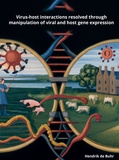Virus-host interactions resolved through manipulation of viral and host gene expression
Summary
Viruses existed long before modern humans evolved and might have been there from the beginning of the evolution of living cells. The corona virus pandemic shows us the danger of acute infections and how easy viruses can spread and evolve. While SARS-CoV-2 is omnipresent, general awareness of herpesvirus infections, which can cause severe and fatal illnesses, is limited. Both coronaviruses and herpesviruses share the ability to evolve with their hosts to develop sophisticated mechanisms to interfere with their host’s immune system to prevent clearance. While EBV, for example, can limit the expression of viral proteins to curtail immune recognition, viral miRNAs are expressed during all stages of infection and likely play important role in EBV infection. Therefore methods to research, control and understand viral miRNAs are of great importance.
Chapter 2 shows the generation and optimization of potent EBV miRNA inhibitors whose efficiency depends on their thermodynamic properties. These inhibitors were subsequently employed in chapter 3 to pinpoint which EBV miRNAs target specific host genes that were identified in a screen for EBV miRNA targets. Here, we identified many new host genes that are regulated by EBV miRNAs. We characterized one specific miRNA that downregulated two genes involved in autophagy resulting in enhanced autophagic flux, which could subsequently aid in viral survival.
Herpesvirus are not only adept in evading immune responses, they furthermore establish latency. Since latent infections cannot be cleared yet with traditional treatments, new methods are needed to tackle this problem. Genome engineering with CRISPR/Cas9 shows great promise in clearing cells of latent viral genomes. Therefore, in Chapter 4 we review how CRISPR/Cas9 is being utilized as an anti-viral tool to target pathogenic human viruses. In chapter 5 we employ CRISPR/Cas9 as a genetic tool to screen for host factors involved in HCMV infection. Here we identified and characterized known and novel genes that are involved in the HCMV infection cycle.
Viruses can interfere with their detection by the host to ensure their survival by e.g. limiting the presentation of viral antigens on the surface of infected cells thereby evading recognition by surveying cytotoxic T cells, thus preventing the clearance of virus infected cells.
Chapter 6 describes a flow cytometry-based method to assess how viral proteins can interfere with the MHC class I antigen pathway. The method can also aid to pinpoint the possible mode of action. In chapter 7 we screened the viral proteins of SARS-CoV-2 for their effect on MHC class I expression and identified a single gene product that interferes with surface expression of HLA-I.
Finally, chapter 8 provides a summarizing discussion and points at potential future research.
